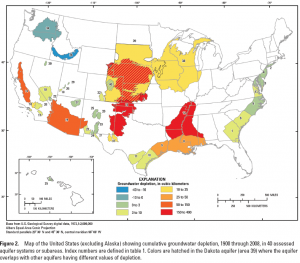Water Scarcity
By Michael FaginWeather Conditions, Weather ExpertWith 0 commentsWater Scarcity in the West Coast of the US is a big issue. In the simplest terms, there’s not enough water to meet the demands of the population and economy of the west. The two sources of water, surface and ground, are interconnected in so many ways it takes a hydrologist to understand it and perhaps an attorney to defend it.
Groundwater is that which is generally pumped from wells of varying depths. The economics are simple, too deep of a well requires more energy to bring the water to the surface which affects the value to which the water is used. Groundwater is held literally, in the ground in aquifer’s. The water is layered. By that I mean the top level of groundwater is usable without treatment. Below that, the water is saline and if more water is pumped out than recharged, the saline water migrates to the top and is either unusable or requires desalinization. Tapping for deep groundwater is an expensive and power intensive process.
Surface water, what we usually see in lakes and streams generally comes from rain and snow runoff. In Eastern Washington, Eastern Oregon and much of California the snowpack is crucial for the agricultural industry. One of the facts of life in the west is irrigation. The U.S. Bureau of Reclamation built, in the 1930’s the great projects, coinciding with the building of the major power generating dams on the Snake and Columbia Rivers were constructed to bring water to the shrub steppe and high desert lands of Central and Eastern Washington and much of the West Coast.
These projects, conceived to alleviate unemployment and to boost food production were immensely successful. With jobs and new farms, more people moved to the area expanding both towns and communities but also increasing the demand for water.
Much attention recently has been focused on the California drought. This has been in place for several years and has resulted in a cascading effect on property owners and farmers. A great deal of the water in the west originates in the Colorado River. Distribution and allocation of this resource is governed by the 1922 Colorado River Compact. This powerful political document was put into place to allow a fair usage of the water resources to the seven signatory states. At the time it was remarkable for ending a series of disagreements among the states over the issue of water sharing.
When it was signed though, the upper basin of the Colorado River had been experiencing a heavier than usual water flow. thus making generosity both expedient and palatable for all concerned. As rain and snow fall declined, less water is now available with more resources allocated than are available.
Conservation rules and practices put in place in Colorado, Wyoming and Utah have kept the water flowing to the other signatories, Nevada, New Mexico, Arizona and California. Nevada, especially Las Vegas has put into place water usage rules that emphasize conservation but which the growth of the area have imperiled. No one anticipated the great grown and water usage in the “Sun Belt.”
Only recently has California enacted stricter water usage statutes with some mixed success. The highly prized green lawns and golf courses may well become a distant memory. One of the new laws is The Sustainable Groundwater Management Act (SGMA) is a revolutionary law that will have profound impacts on the state’s agriculture industry. This might take years to figure out and perhaps legal challenges.
The entire West Coast has seen a decline of snowpack and retreat of glaciers which leads to a lower system recharge of groundwater. Here again, agriculture is heavily dependent on irrigation. It has also become a priority to repair fish stocks, especially of salmon, to per-industrial stages and runs. This is not an easy or cheap task, but is considered essential not only for Native American tribes but also the sport and commercial; fishing industries.
Solutions are not easy to construct or sell to the public. Conservation, obviously is a priority . A renegotiation of the Compact, is a possibility. Desalinization projects would help, especially along coastal regions. Slowing the effects of carbon flowing into the atmosphere may help. Population migration from areas with a lack of water resources has always been a traditional option but is more difficult to effect without an economic disruption that may actually make things worse. This will take many years to unravel and many have said that water is the new oil.
Written by Bob Morthorst

Groundwater depletion from “USGS”
